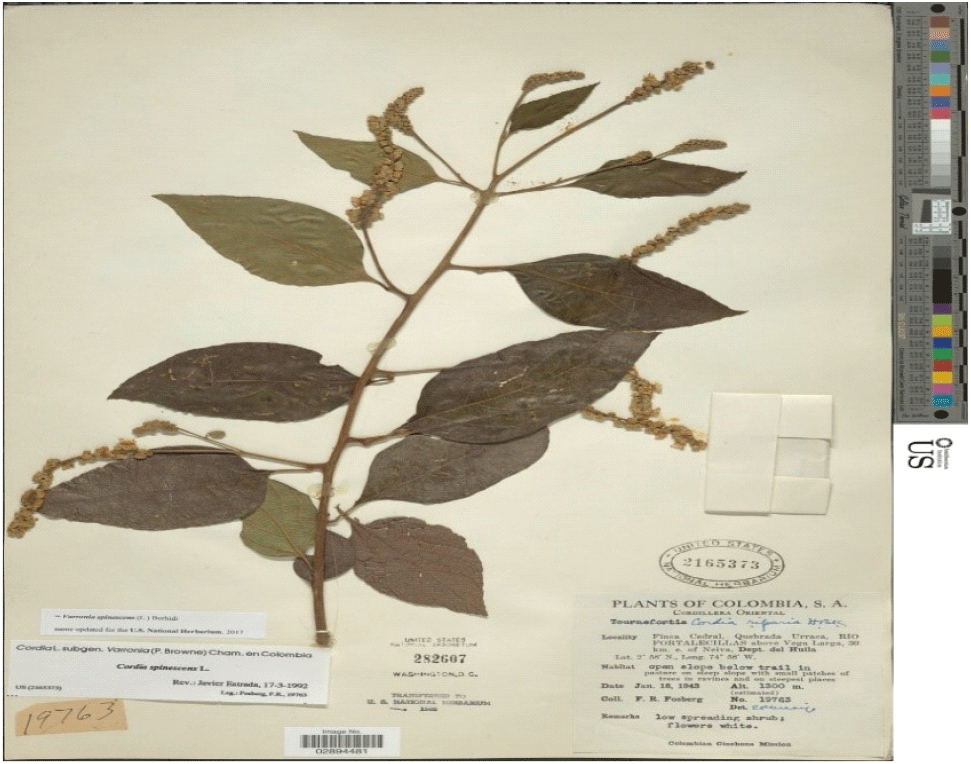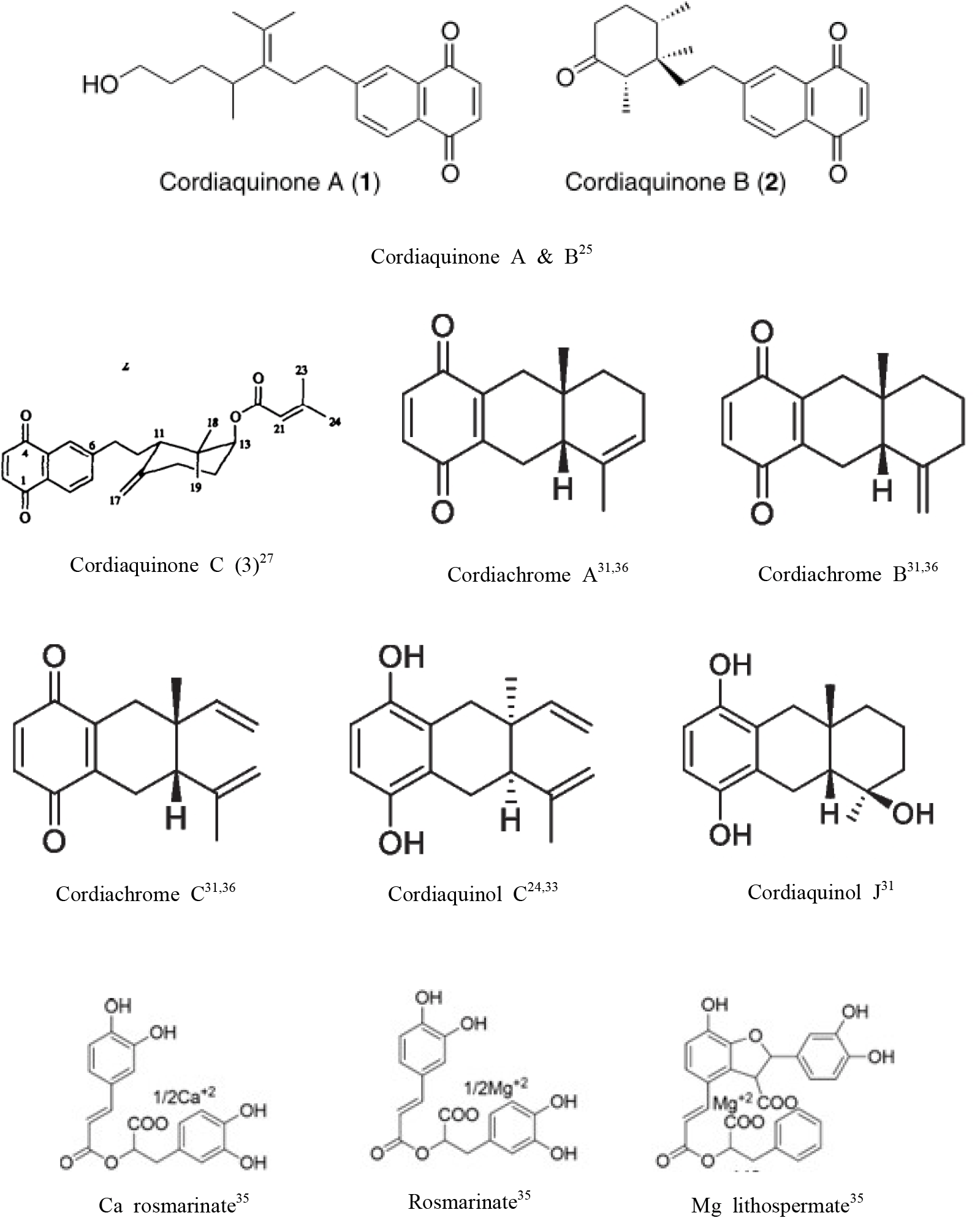I. Introduction
About 2,500 to 2,700 different species are included in the existing large taxonomy of Boraginaceae (1, 2). Four subfamilies have traditionally been recognized for the Boraginaceae family: Cordioideae, Ehretioideae, Heliotropioideae, and Boraginoideae (3). Current molecular research includes two additional subfamilies, Lennoaceae and Hydrophyllaceae inside the Boraginaceae, challenging frequently family divides. Within Cordiaceae, Varronia is proposed as a distinct genus (4). There are four natural species of Varronia on the Galápagos archipelago (5). Approximately 125 species make up the genus Varronia, which is native to the Neotropics and is categorized under the Cordiaceae family (formerly thought to be a part of the Boraginaceae family) (6) (Figure 1).

Varronia was once thought to be synonymous with Cordia (7). It has been determined that the genus Varronia is the sister group of the remaining species in the genus Cordia (8). Varronia spinescens is synonymized with numerous terms, notably Cordia spinescens L and Quarena spinescens (https://www.catalogueoflife.org/annual-checklist/2014/details/species/id/16703224).
Varronia exhibits shrubs with many stems that have clearly serrated edges and craspedodromous venation, displaying the three primary forms of inflorescences: spicate, cymose, and capitate (4). Six different types of pollen are also found in Varronia (9).
Several species of the Boraginaceae family, which is distributed around the world, live in xeric and seasonally dry environments in both tropical and temperate biomes (10). Varronia is monophyletic, according to phylogenetic studies, but no single analysis included more than 17 species (3).
The total content of phenolic compounds represents great diversity in Boraginaceae family. Similarly, the Varronia species shows different flavanones and flavonoids (11, 12). Scaevola spinescens is confirmed as a rich source of total phenolic content with diverse antioxidant properties (13), variations in bioactive compounds exist among plant parts (2). The composition of chemicals by plants can be influenced by various factors such as seasonal, temperature, brightness, water supply, nutrient content, epidemic infection and genetics (14). Several studies state that the Boraginaceae family is strongly recommended for use in medicine (15). Symphytum officinale L., often known as comfrey, is widely accessible as over-the-counter preparations for use by practitioners, healthcare professionals, and consumers. It is believed to be effective in treating wounds, musculoskeletal problems, and a variety of other conditions (16). Comfrey has been used as a lotion to treat rheumatism because of its anti-inflammatory properties (17). Greek indigenous Rindera graeca closely related to Varronia is rich in bioactive components that have antioxidant properties, including rutin, quercetin-3-rutinoside-7-rhamnoside, and rosmarinic acid. It is also reported to contain Echinatine which is a pyrrolizidine alkaloid having pharmacological potential (18). The leaf extracts of Scaevola spinescens has the ability to inhibit Cutibacterium acnes which cause acne vulgaris, an infectious disease that effect mainly teenagers (19). Additionally, it has been stated that the most effective anti-human cytomegalovirus is Scaevola spinescens (20).
Certain phenolic components found in Varronia curassavica leaf ethanol extract have antioxidant properties against reactive oxygen species (ROS) and synthetic radicals (21), ROS are chemicals that the body produces and are linked to the aging process (22). Recently there has been a general increasing trend in the demand for nutritional plants in the world (14). The primary goals of this review are to examine the reproductive behavior, examine the phytochemical content, and evaluate the potential health benefits of Varronia spinescens.
II. Evaluating the Chemical Diversity of Cordia Species
Primary classifications for quinones found in Cordia species include meroterpenoid hydroquinones, meroterpenoid benzoquinones, and meroterpenoid naphthoquinones (23, 24). Cordiaquinones, a class of meroterpenoid compounds, have been found and isolated from a number of Cordia species (25). Different Cordia species provide distinct Cordiaquinones (26, 27), including A, B, and C, identified as meroterpenoid naphthoquinones in Cordia corymbose (28).
Currently, twenty-two Cordia species have yielded seventy quinones, among which Cordiachromes A, B, and C are isolated meroterpenoid quinones (29). An aromatic precursor unit and precursor chemicals like geranyl pyrophosphate are involved in the formation and biosynthesis of Cordiachromes (30). Among the numerous biological activities that Cordiachromes display are leishmanicidal (31) and antifungal qualities (32). Research has indicated that Cordiaquinol J and C can be isolated from wood of the Cordia fragrantissima plant. It has been observed that Leishmania guyanensis promastigotes are effectively inhibited by Cordiaquinol J and C (33).
Additionally, many phenols, polyphenols, and terpenoid benzoquinones of Cordia spinescens have been isolated and identified (34). From the leaves of Cordia spinescens, researchers extracted three chemical compounds, including magnesium lithospermate, calcium rosmarinate, and magnesium rosmarinate. These substances have potential anti-HIV properties (35). Typical compounds found in Cordia species as shown in Figure 2.
III. Reproductive Strategies and Floral Morphology of Varronia spinescens
The species in question is classified as heterostyly due to the presence of a heteromorphic incompatibility system (37). Heterostyly has reciprocal positioning of stigma and another heights in various floral morphologies, similar to distyly and tristyly (38), promising successful pollination (39).
In Varronia spinescens, a distylous plant with reciprocal sexual organ placements, heterostyly encourages cross-pollination. By allowing a wide variety of pollinators to coexist, strong reciprocity preserves its sexual diversity (37). These sexual polymorphisms particularly geitonogamy are thought of as floral designs that improve precise cross-pollination and reduce the risk of missed mating opportunities due to self-interference (38). Varronia curassavica’s reproductive system displays protogyny and heterostyly. As pollinators, insects such as Diptera, Hymenoptera, and Lepidoptera support biodiversity and the organism’s ability to survive (40).
IV. Exploring Therapeutic Potential: Bioactive Substances in Different Varronia Species
A comparison and analysis of 17 species of Boraginaceae shows that they are a good source of biologically active compounds (41). Varronia multispicata is an important plant in folk medicine for many health conditions since it has historically been utilized for respiratory, digestive, inflammatory, and infectious disorders (42). In the essential oils of Varronia multispicata and other Varronia species, sesquiterpenes were found to be the most common class of component (43, 44). Several species of Varronia, including Varronia spinescens, were traditionally used against the bites of snakes because the mentioned secondary metabolites, such as flavonoids, and retinoids, have been studied for their inhibitory capacity against certain toxins, specifically phospholipases A2 from snake venom (45). This inhibition is significant as phospholipases A2 is a key enzyme in the toxic effects of snake venom (46).
The identified flavanones and chalcones in the leaves of Varronia dardani have the potential to be the source of the spasmolytic effect (47) by blocking the actions of the enzymes catechol-O-methyltransferase and monoaminooxidase A; additionally certain flavonoids also attach to the GABAA receptor (48). Its essential oils has strong antibacterial and antifungal properties (49).
Research conducted on Varronia leucocephala reveals that Cordiaquinone J produces reactive oxygen species (ROS), which is an antiproliferative impact. These outcomes include the induction of cell necrosis and apoptosis (50).
The essential oils (EOs) extracted from seven varieties of Varronia curassavica plants showed efficacy against the damaging agricultural disease caused by Phytomonas serpens. In one study, it was discovered that VC-202 was the most successful essential oil at eliminating Phytomonas (51) and the level of cytotoxic effect of the plants against murine macrophages increased with increase in plant age (52). Additionally, Varronia carassavica essential oil has anti-inflammatory and phytotherapeutic properties (44). Rodrigues and co-workers reported promising antiglycation potential of the components brickellin and cordialin A in the extract from Varronia curassavica, indicating potentially important therapeutic applications (53).
Varronia globosa is a traditional remedy for a variety of ailments (54), and its essential oil has shown antibacterial activity against significant medically relevant bacterial and fungal species (55). An eco-friendly pesticide against Tribolium confusum in stored goods appears to be possible with the essential oil of V. globosa, particularly anethole (56). In addition, its roots contained meroterpenoid benzoquinones that showed strong cytotoxic action against a range of cancer cell types (57).
It implies that Varronia schomburgkii extract may have cosmetic uses for skin care, especially in terms of enhancing skin brightness or lightening (58, 59). Moreover, its extracts show anti-aging and anti-free radical characteristics, as well as stimulating the auto-synthesis of reduced glutathione (60). Furthermore, Varronia schomburgkii’s essential oil functions as a natural antifungal remedy that is especially successful against strains of Candida (61).
V. Conclusion
Boraginaceae includes more than 2,500 species distributed around the world. One of its species, Varronia spinescens, a distylous plant with heterostyly, is significant in ecological, pharmacological, and evolutionary contexts. Seasonally, dry and xeric environments are ideal for the growth of Varronia spinescens. Successful cross-pollination is encouraged by its distinct floral morphology and heterostylous reproductive system. Reciprocity in the locations of sexual organs promotes diversification and maintains the survival of the plant. Notably, this species harbors a wide variety of phytochemicals that may have therapeutic applications. This review highlights the ecological significance, medicinal value, and phylogenetic importance of Varronia spinescens and related genera urging further exploration of its potential in various fields.

